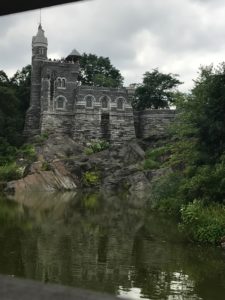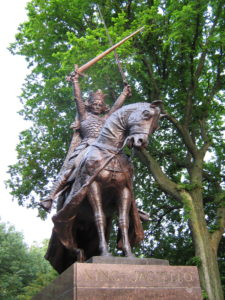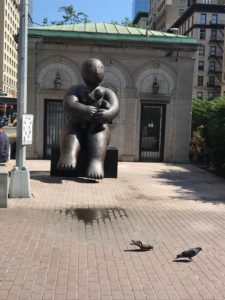By Kirsten McLaren
Central Park is an oasis of green in a city known as a concrete jungle. It’s the perfect place to find concerts, amusement parks, birdwatching, races, or even to read a good book.
Central Park is also famous for the statues and landmarks that lie within. Experience a taste of a childhood fairytale or explore Central Park’s very own castle!
Statues glitter in the sun in Central Park. Families crowd around statues, trying to snap a picture of their children in front of landmarks such as Alice in Wonderland, the Belvedere Castle, and King Jagiello.
The Alice in Wonderland statue, constructed in 1959 by José de Creeft, was designed to resemble the original illustrations by John Tennial in Lewis Carroll’s story.
“My daughters love it. It’s their favorite place in the park,” said Stephen D., 42, from Manhattan.
The statue features Alice, the Cheshire Cat, White Rabbit, Mad Hatter, Dormouse and Alice’s cat, Dinah. De Creeft designed the Mad Hatter’s face to resemble George Delacorte Jr, who commissioned the project.
“Alice in Wonderland is my favorite princess so I really really really love it,” said Skylar F., 4.
It is located just north of the Conservatory Water at East 74th Street.
The granite circle surrounding the statue has an engraving of a line from “The Jabberwocky,” one of Carroll’s poems: “Twas brillig, and the slithy toves did gyre and gimble in the wabe.”
Belvedere Castle, Italian for “beautiful view,” was designed in 1865 by Calvert Vaux and Jacob Wrey Mould.
“I love the castle, it’s beautiful. I used it for my wedding photos,” said Raquel A, 27.
Originally designed as a lookout, the weather instruments in its highest tower began to provide weather data in 1919. It now also serves as an iconic photo backdrop.
After renovations in 1983, the castle now contains the Henry Luce Nature Observatory.
The Observatory houses natural history artifacts and provides equipment for those who want to see Central Park through a scientist’s lens.
An ideal birdwatching spot, the castle gives you the chance to see hawks, ospreys and kestrels.
The castle also holds various events including birding events, astronomy talks, storytelling and a haunted house each Halloween.
Belvedere Castle is located mid-park at 79th Street.
With his swords crossed overhead, “King Jagiello” can appear menacing but the statue is instead a symbol of pride and courage.
“King Jagiello” was originally featured at the entrance to the Polish Pavilion at the 1939 New York World’s Fair in Flushing Meadows, Queens. One year later, Nazis invaded Poland and the statue couldn’t be returned home.
In 1945, the Polish government placed the statue in Central Park permanently as a symbol of Polish pride and courage.
King Jagiello, Grand Duke of Lithuania, became King when he married the Queen of Poland in 1386. With the marriage, he united Lithuania and Poland.
The statue depicts the Battle of Grunwald in 1410 when the King crossed the two swords handed to him by his adversaries, Teutonic Knights of the Cross, over his head to demonstrate his strength.
“King Jagiello” is located mid-park at 79th Street on the east side of the Turtle Pond.
All photos by Kirsten McLaren



Art on Broadway
Sculptures decorate Broadway, one of Manhattan’s busiest roadways, for passerby’s enjoyment. The ever-changing art lies in the malls that separate the uptown and downtown traffic.
Since 2005, the Broadway Mall Association has been displaying public art from artists all around the world.
Currently, BMA is displaying works in nine of the Broadway Malls from 72nd Street to 166th Street. Sculptures byJoy Brown made their debut on Broadway on May 17, 2017 and will be removed in November.
The larger-than-life bronze sculptures are designed to suggest a “warmth and lightness of being,” said the Broadway Mall Association website.
Brown’s roots in Japan aid to the Japanese aesthetic represented in her work.
Brown’s is the tenth exhibition that BMA has displayed since 2005.
In the past, BMA has displayedwork by Don Gummer, Broadway Moore Boogie, Saint Clair Cemin, Peter Woytuk, Manolo Valdés, Carole Eisner, Chakaia Booker, Boaz Vaadia, and Tom Otterness.
In 2009, Broadway Mall Association added an information line where visitors could call the number indicated at any given sculpture and hear the artists’ description of the piece. Listeners could also leave comments. In 2010, BMA installed the same in Spanish.
BMA has the guidelines for prospect artists’ works on their website. BMA Guidelines tell how to submit a proposal.
Artists are encouraged to select specific malls and to use at least three malls to display their works however, the BMA and the Parks reserve the right to decide exhibition sites.
Art must be anchored to the hardscape to prevent theft and damage Artists are responsible for the restoration of the area after the exhibition is complete.
Artists and/or sponsors are required to provide property and liability insurance. BMA does not claim any responsibility for the art.
If you want to view Joy Brown’s works, they are located along Broadway at 72nd St, 79th St, 96th St, 103rd St, 117th St, 148th St, 157th St and 166th St.


Kirsten McLaren is a rising junior at Lexington High School in Lexington, Massachusetts.